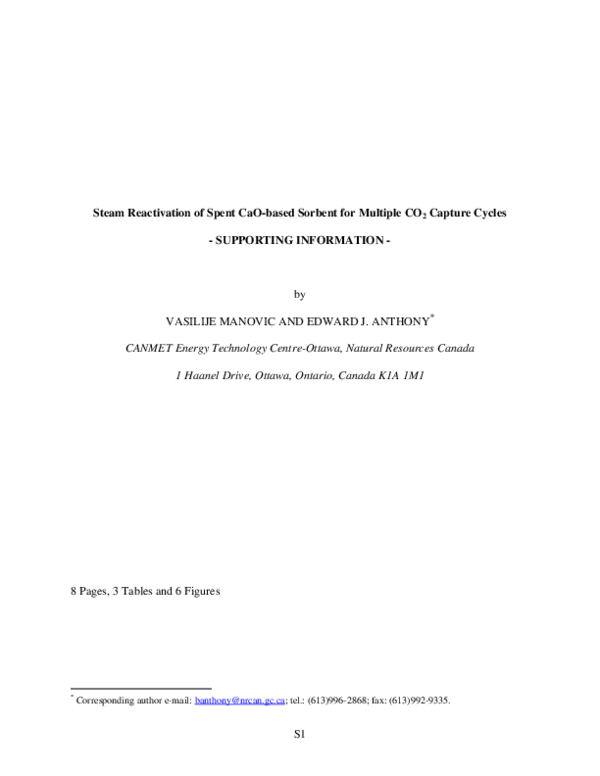Steam Reactivation of Spent CaO-based Sorbent for Multiple CO2 Capture Cycles
- SUPPORTING INFORMATION -
by
VASILIJE MANOVIC AND EDWARD J. ANTHONY*
CANMET Energy Technology Centre-Ottawa, Natural Resources Canada
1 Haanel Drive, Ottawa, Ontario, Canada K1A 1M1
8 Pages, 3 Tables and 6 Figures
*
Corresponding author e-mail: banthony@nrcan.gc.ca; tel.: (613)996-2868; fax: (613)992-9335.
S1
�TABLE S1. Results of TGA analyses of sorbent hydrated after CO2 cyclesa
Sample
KR37 (75-150 μm)
KR38 (300-425 μm)
KR39 (600-750 μm)
KR40 (75-150 μm)
KR41 (300-425 μm)
KR42 (600-750 μm)
CaO sulphated
(%)
29.77
28.09
26.59
0.00
0.00
0.00
CaO carbonated (%) CaO hydrated CaO unreacted
(%)
(%)
Before
After
4.69
10.44
50.66
9.13
4.08
8.72
53.98
9.21
4.86
9.60
55.76
8.05
19.31
24.80
68.74
6.46
14.60
18.98
70.74
10.28
16.46
20.76
70.55
8.68
a
The values of CaO sulphated were calculated on the basis of mass increment at end of sulphation step and
represent the CaSO4/totalCaO molar ratio. The values of CaO hydrated and carbonated were calculated on the
basis of mass loss in the TGA experiments, which correspond to the Ca(OH)2 and CaCO3 decomposition and
represent the Ca(OH)2/totalCaO and CaCO3/totalCaO molar ratio, respectively. The values of CaO unreacted
are calculated by difference.
TABLE S2. Behavior of Kelly Rock limestone in cyclic carbonation – short cycles
Sample
KR01 (75-150 μm)
KR02 (300-425 μm)
KR03 (600-750 μm)
X1-2 (%)
64.75
64.89
66.50
X9-10 (%)
31.13
38.72
35.82
X29-30 (%)
24.95
29.32
27.02
X1-10 (%)
44.03
48.83
47.17
X1-30 (%)
32.10
37.17
36.98
TABLE S3. Results of TGA analysesb of sorbent calcined/sintered under different
conditions and hydrated, where some fraction of CO2 in samples is probably result of
reaction with CO2 in air during sample manipulation
Sample
KR43 (75-150 μm)
KR44 (300-425 μm)
KR45 (600-750 μm)
KR46 (75-150 μm)
KR47 (300-425 μm)
KR48 (600-750 μm)
KR49 (75-150 μm)
KR50 (300-425 μm)
KR51 (600-750 μm)
b
Conditions during CaO carbonated CaO hydrated CaO unreacted
calcination/sintering
(%)
(%)
(%)
1100°C, 24 h
5.88
82.50
11.62
1100°C, 24 h
2.42
83.02
14.56
1100°C, 24 h
2.85
81.59
15.56
850°C, 24 h
8.62
80.15
11.23
850°C, 24 h
3.67
88.62
7.71
850°C, 24 h
4.36
91.89
3.75
850°C, 2 h
5.75
87.86
6.39
850°C, 2 h
4.19
88.59
7.22
850°C, 2 h
5.18
87.89
6.93
The values of CaO hydrated and carbonated were calculated in the same way as in Table S1.
S2
�100
KR01 (0.075-0.150 mm)
Carbonation degree [%]
90
80
70
60
50
40
30
20
10
0
0
50
100
150
200
250
300
350
400
450
Time [min]
a)
100
KR02 (0.300-0.425 mm)
Carbonation degree [%]
90
80
70
60
50
40
30
20
10
0
0
50
100
150
200
250
300
350
400
450
Time [min]
b)
100
KR03 (0.600-0.750 mm)
Carbonation degree [%]
90
80
70
60
50
40
30
20
10
0
0
c)
50
100
150
200
250
300
350
400
450
Time [min]
FIGURE S1. TGA calcination/carbonation results for original limestone, particle size: 75150 μm (a), 300-425 μm (b), and 600-750 μm (c).
S3
�100
KR38 (0.300-0.425 mm), 28.09% sulfated
Total CaO utilization [%]
90
80
70
60
50
40
30
20
Irreversibly used part of CaO in form of CaSO4
10
0
0
50
100
150
200
250
300
350
400
450
Time [min]
a)
100
KR39 (0.600-0.750 mm), 26.59% sulfated
Total CaO utilization [%]
90
80
70
60
50
40
30
20
Irreversibly used part of CaO in form of CaSO4
10
0
0
50
100
150
200
250
300
350
400
450
Time [min]
b)
FIGURE S2. TGA calcination/carbonation results for reactivated partially sulphated spent
sorbent, particle size: 300-425 μm (a), and 600-750 μm (b).
S4
�100
KR40 (0.075-0.150 mm)
Carbonation degree [%]
90
80
70
60
50
40
30
20
10
0
0
50
100
150
200
250
300
350
400
450
Time [min]
a)
100
KR41 (0.300-0.425 mm)
Carbonation degree [%]
90
80
70
60
50
40
30
20
10
0
0
50
100
150
200
250
300
350
400
450
Time [min]
b)
100
KR42 (0.600-0.750 mm)
Carbonation degree [%]
90
80
70
60
50
40
30
20
10
0
0
50
100
150
200
250
300
350
400
450
Time [min]
c)
FIGURE S3. TGA calcination/carbonation results for reactivated unsulphated spent
sorbent, particle size: 75-150 μm (a), 300-425 μm (b), and 600-750 μm (c).
S5
�100
KR01 (0.075-0.150 mm)
Carbonation degree [%]
90
80
70
60
50
40
30
20
10
0
0
50
100
150
200
250
300
350
400
Time [min]
a)
100
KR02 (0.300-0.425 mm)
Carbonation degree [%]
90
80
70
60
50
40
30
20
10
0
0
50
100
150
200
250
300
350
400
Time [min]
b)
100
KR03 (0.600-0.750 mm)
Carbonation degree [%]
90
80
70
60
50
40
30
20
10
0
0
50
100
150
200
250
300
350
400
Time [min]
c)
FIGURE S4. TGA calcination/carbonation results for original limestone – 30 short-time
cycles, particle size: 75-150 μm (a), 300-425 μm (b), and 600-750 μm (c).
S6
�100
KR43 (0.075-0.150 mm)
Carbonation degree [%]
90
80
70
60
50
40
30
20
10
0
0
50
100
150
200
250
300
350
400
450
Time [min]
a)
100
KR44 (0.300-0.425 mm)
Carbonation degree [%]
90
80
70
60
50
40
30
20
10
0
0
50
100
150
200
250
300
350
400
450
Time [min]
b)
100
KR45 (0.600-0.750 mm)
Carbonation degree [%]
90
80
70
60
50
40
30
20
10
0
0
50
100
150
200
250
300
350
400
450
Time [min]
c)
FIGURE S5. TGA calcination/carbonation results for sorbent sintered at 1100°C, 24 h, and
reactivated, particle size: 75-150 μm (a), 300-425 μm (b), and 600-750 μm (c).
S7
�a)
b)
c)
d)
FIGURE S6. SEM images of spent sorbent (a – sulphated, b – unsulphated) and reactivated
sorbent after calcination (c – sulphated, d – unsulphated)
S8
�

 Edward J Anthony
Edward J Anthony